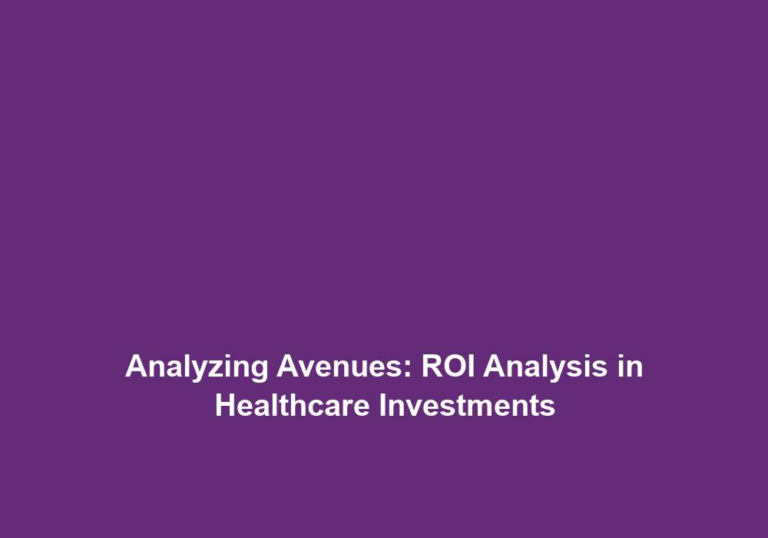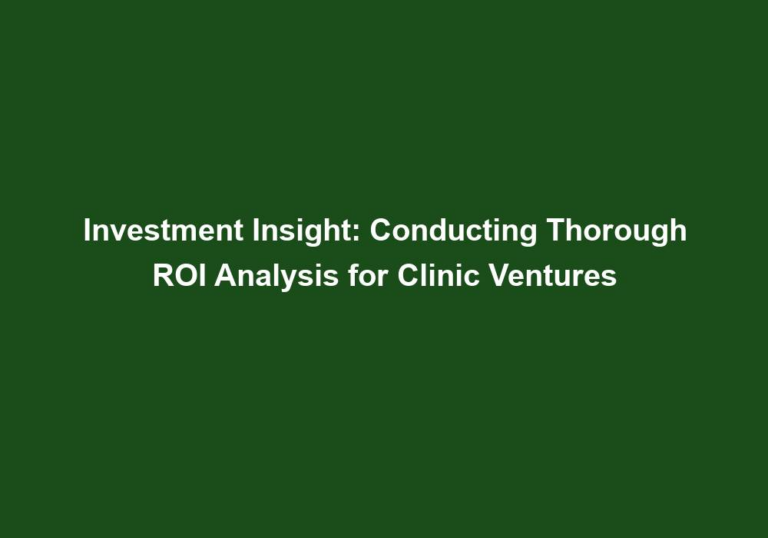Analyzing Avenues: ROI Analysis in Healthcare Investments
In today’s rapidly evolving healthcare industry, making informed investment decisions is crucial for organizations to thrive and deliver high-quality patient care. One essential tool that can guide these decisions is Return on Investment (ROI) analysis. By analyzing various avenues for investment and evaluating their potential ROI, healthcare organizations can allocate resources efficiently and maximize their financial returns. In this article, we will delve into the concept of ROI analysis in healthcare investments, its importance, and key factors to consider when conducting such analyses.
Understanding ROI Analysis
ROI analysis is a financial tool that measures the profitability or potential return of an investment relative to its cost. It enables organizations to quantify the benefits and drawbacks associated with different investment opportunities. In the context of healthcare investments, ROI analysis plays a pivotal role in assessing the financial viability and strategic value of various projects, such as acquiring new technologies, expanding facilities, or implementing innovative healthcare programs.
ROI analysis involves a comprehensive assessment of the financial implications of an investment. It takes into account factors such as the initial investment cost, projected revenue generation, cost reduction opportunities, and the timeframe for achieving a positive ROI. By considering these factors, healthcare organizations can make informed decisions about which investments offer the highest potential returns.
Importance of ROI Analysis in Healthcare Investments
Efficient allocation of resources is crucial for healthcare organizations, as they face ever-increasing demands while also striving to control costs. ROI analysis provides a systematic approach to evaluate potential investments, ensuring that resources are channeled towards projects that offer the highest returns. Here are some key reasons why ROI analysis is vital in healthcare investments:
-
Financial Decision-Making: ROI analysis enables healthcare organizations to make informed financial decisions by comparing the potential returns from different investment options. It helps prioritize projects and allocate resources in a way that maximizes financial gains. By considering the potential ROI, organizations can determine which investments are most likely to generate substantial profits and contribute to their overall financial health.
-
Risk Assessment: By conducting an ROI analysis, healthcare organizations can assess the risks associated with potential investments. Examining the potential returns against the risks allows organizations to evaluate whether an investment aligns with their risk appetite and long-term goals. This helps mitigate the potential negative impact of investments that may not yield the expected returns or carry significant risks.
-
Resource Optimization: Healthcare organizations often operate with limited resources. ROI analysis helps identify investments that have the potential to generate substantial returns, allowing organizations to optimize their resources and avoid investing in projects with low profitability. By prioritizing investments with higher ROI, organizations can maximize the value they derive from their available resources.
-
Strategic Planning: ROI analysis contributes to strategic planning by providing insights into the financial impact of various investment avenues. It helps organizations align their investment decisions with their long-term objectives, enabling them to stay competitive and adapt to changing market dynamics. By considering the potential ROI of different investments, organizations can strategically allocate resources to initiatives that support their overall growth and sustainability.
Key Factors to Consider in ROI Analysis
While conducting an ROI analysis in healthcare investments, several factors must be taken into account to ensure accuracy and reliability. Here are some key factors to consider:
1. Initial Investment Cost
The initial investment cost serves as the foundation for ROI analysis. It includes expenses related to equipment, technology, facility expansion, training, and implementation. Accurately capturing all costs associated with the investment is essential to calculate an accurate ROI. By conducting a thorough assessment of the initial investment cost, organizations can have a clear understanding of the financial commitment required for a particular investment.
2. Revenue Generation
Estimating the potential revenue generation resulting from the investment is crucial. This involves forecasting the anticipated increase in patient volume, revenue per patient, and any potential cost savings. Detailed financial projections and market analysis can aid in estimating revenue generation accurately. By considering the potential revenue generation, organizations can assess the financial feasibility of an investment and determine its potential impact on the bottom line.
3. Cost Reduction
Assessing the potential cost reductions resulting from the investment is equally important. This could include reductions in operational costs, streamlined processes, and increased efficiency. Careful analysis of how the investment can positively impact cost reductions is essential for an accurate ROI calculation. By identifying potential cost-saving opportunities, organizations can evaluate the long-term financial benefits of an investment and determine its overall impact on operational efficiency.
4. Timeframe for ROI
Determine the timeframe within which the investment is expected to generate a positive ROI. This timeframe should be realistic and aligned with the nature of the investment. Short-term investments may yield quicker returns, while long-term investments may require a more extended period to realize their full potential. By establishing a realistic timeframe for ROI, organizations can set appropriate expectations and evaluate the feasibility of an investment within a specific time frame.
5. Consideration of Intangible Benefits
In addition to financial gains, it is crucial to consider the intangible benefits resulting from an investment. This could include improved patient satisfaction, enhanced reputation, increased market share, or improved quality of care. While challenging to quantify, acknowledging these intangible benefits provides a comprehensive analysis. By considering the intangible benefits, organizations can assess the holistic impact of an investment and determine its value beyond monetary returns.
Conclusion
In the ever-evolving landscape of healthcare, ROI analysis serves as a valuable tool for organizations aiming to make informed investment decisions. By carefully evaluating potential investments, healthcare organizations can allocate resources effectively, optimize financial returns, and strategically plan for the future. Considering factors such as initial investment cost, revenue generation, cost reduction, timeframe for ROI, and intangible benefits provides a comprehensive approach to conducting ROI analysis. Ultimately, harnessing the power of ROI analysis empowers healthcare organizations to drive financial growth, deliver exceptional patient care, and stay ahead in a competitive industry.






